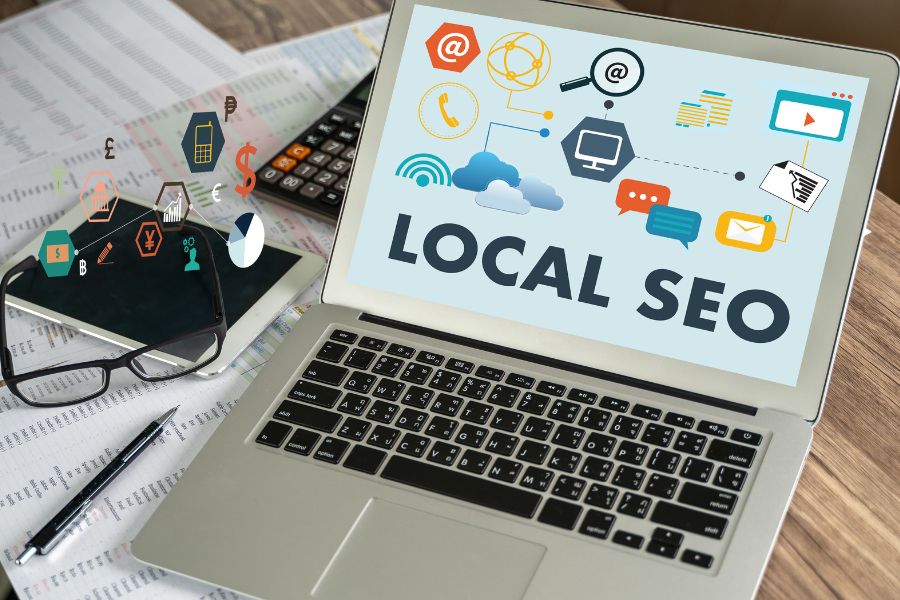Mastering local SEO doesn’t need to be a daunting task.
If you’ve ever felt lost amidst ever-changing search engine algorithms, you’re not alone.
But what if you could boost your local business visibility and outrank your competition, all using proven strategies?
With actionable insights, specific examples, and a bit of perseverance, you can do just that.
So, grab your note-taking tools, and let’s dive right in.

What is Local SEO & How Does it Work?
At its core, Local SEO, or Local Search Engine Optimization, is a tailored digital marketing strategy designed to optimize your online presence, aiming to attract more business from relevant local searches happening on Google and other search engines.
Imagine you’re craving a slice of pizza. You pick up your phone and type “pizza near me” into Google.
The results you’re shown are not a coincidence but a carefully calculated display of local businesses that have leveraged local SEO.
Likewise, if you’ve ever been surprised by how Google seems to know exactly where you are when delivering search results, that’s local SEO at work.
You might be wondering…
How does local SEO achieve this?
The engine driving local SEO might seem complicated at first glance, but it becomes more manageable once you dissect it.
Local SEO primarily concentrates on three crucial areas: relevance, distance, and prominence.
Let’s delve a little deeper into these factors…
- Relevance: This refers to how well your business fits the searcher’s intent
- Distance: This is simply how far the searcher is from the location of your business. If you have specified a service area, Google will also consider this factor when ranking your business.
- Prominence: This signifies how well-known or popular your business is. Google considers both online and offline prominence.
Let’s say you run a local bakery. When a potential customer in your area searches for a bakery, Google will use these three factors to determine your ranking in the local search results.
The better you perform in relevance, distance, and prominence, the higher you’re likely to rank, leading potential customers right to your door.
Why is Local SEO Important?

As a local business owner, the prosperity of your enterprise is deeply intertwined with your visibility in local search results.
The reason is simple…
We live in a digital age where “Google it” has become a reflexive response to most queries.
As such, the impact of local SEO on your business’s success cannot be underestimated.
In fact, Google has reported that a staggering 46% of all searches have a local intent.
What this statistic reveals is that nearly half of all Google search users are looking for local information.
What does it mean for you?
If your business isn’t optimized for local search, you’re potentially missing out on nearly half of your prospective customers.
Moreover, local SEO also helps you level the playing field against larger, more established businesses.
It gives you a chance to stand out based on your location and specific offerings, rather than compete against nationwide or global brands with larger marketing budgets.
Another important aspect to consider is the rise of mobile searches.
People are increasingly searching on the go, using phrases like “near me” or “open now”.
If your business is locally optimized, you’re more likely to capture these searchers as they’re ready to make a purchase.
Ultimately, implementing a solid local SEO strategy not only enhances your online visibility but also increases foot traffic, boosts your reputation, and accelerates sales.
So, let’s roll up our sleeves and dive deeper into how you can master local SEO to unlock your business’s true potential.
First, the most critical tools that can help you optimize your local SEO strategy…
The #1 Local SEO Tool: Google My Business

Google My Business (GMB) is an indispensable tool in your local SEO toolkit.
This free tool lets you manage your online presence across Google’s ecosystem, including Search and Maps.
By using GMB effectively, you can create and regularly update your Business Profile, which makes it easier for customers to discover and learn about your business.
Below, we detail how you can maximize your Google My Business optimization for local SEO…
Step 1: Claim & Verify Your Google My Business Listing
The first step is to claim your GMB listing. This process involves providing important information about your business, such as its name, address, phone number, business hours, and more.
The next critical step is to verify your listing.
Verification can be completed via mail, phone, or email, depending on your business type.
Step 2: Provide Comprehensive & Precise Information
Accuracy is key when providing information in your GMB listing. Ensure all details, including your business name, address, and contact information, are current and accurate.
An accurate listing not only aids in providing excellent customer experience but also bolsters your local SEO efforts.
Step 3: Regularly Update Your Listing
Maintaining your listing is not a one-time task; it requires regular updates. Keep your GMB profile fresh by frequently adding new photos, posts, and responding to customer reviews.
An updated profile attracts more engagement, signaling Google that your business is active and relevant to users.
Step 4: Utilize Google Posts
Google Posts is a feature that allows you to share updates, promotions, events, and more directly on your GMB profile.
Regularly creating posts is an effective way to interact with your audience and keep them informed about your business’s latest news.
Step 5: Encourage & Respond to Reviews

Customer reviews have a dual effect; they not only sway potential customers but also influence your local SEO ranking.
Prompt your satisfied customers to leave reviews and ensure you respond to them, regardless of whether they are positive or negative.
Google appreciates businesses that actively engage with their customers.
Step 6: Add High-Quality Photos
Quality images can significantly enhance your GMB profile. They provide a visual peek into your business, products, or services, making your listing more attractive and informative.
Regularly adding photos can encourage potential customers to choose your business over others.
Step 7: Optimize Your Business Description
Your business description on GMB is an excellent place to highlight what sets you apart from your competitors.
Use relevant keywords naturally within your description.
However, avoid keyword stuffing, as it can lead to penalties.
Step 8: Leverage the Q&A Section
The Q&A section on your GMB listing can provide valuable information to potential customers. Monitor this section closely and promptly answer any questions asked.
You can also proactively add frequently asked questions to this section.
Step 9: Analyze Insights
GMB provides insights that can help you understand how people are interacting with your business listing, how they found you, where they are coming from, and more.
These insights can be used to fine-tune your local SEO strategy and make data-driven decisions.
7 Top Local SEO Tips That’ll Elevate Your Strategy

Mastering local SEO involves implementing several strategies and leveraging multiple SEO tools.
Here are some top local SEO tips to consider…
1. Conduct SEO Keyword Research
SEO keyword research is akin to finding the secret language your potential customers are speaking.
It’s a crucial step in understanding what terms your customers are using when searching for services or products you offer.
There are several tools available for this, such as Google’s Keyword Planner and Moz Local, which can guide you to find local keywords most relevant to your business.
Picture this… you run a vegan restaurant in New York.
Using keyword research tools, you find that there are high search volumes for terms like “best vegan restaurant in New York” or “New York vegan dining.”
These are the keywords you’ll want to focus on integrating throughout your website’s content, meta descriptions, and titles.
Remember, when conducting keyword research, you’re looking for that sweet spot — terms that have high search volumes but low competition.
The lower the competition, the easier it is for you to rank higher in search results using these keywords.
Also, consider using long-tail keywords — these are longer, more specific phrases that searchers use.
They might have lower search volumes, but they can often have higher conversion rates, as they’re more specific to what the searcher wants.
2. Don’t Forget Local Keywords
It’s no secret that keywords are a significant part of SEO strategy, but did you know the impact local keywords can have on your visibility?
When you incorporate local keywords — words and phrases relevant to your area and business — into your website’s metadata, title tags, and content, you’re essentially placing a digital pin in the map.
You’re telling Google and other search engines where you’re located and what you offer.
So how does this work in practice?
Let’s stick with our New York vegan restaurant example. Instead of using only “vegan restaurant” as a keyword, try “vegan restaurant in New York,” or even more specific, “vegan restaurant in Manhattan.”
Use these location-specific keywords in your website content, blog posts, and meta descriptions.
This strategy can significantly enhance your local search ranking, making it easier for potential customers in your area to find you.
3. Generate Positive Reviews

Customer reviews are the modern word-of-mouth — they can make or break your online reputation.
Moreover, they play a pivotal role in your local SEO ranking.
Encourage your satisfied customers to leave positive reviews on your Google Business Profile. The more high-quality reviews you have, the higher you may rank in local search results.
Here are a few strategies to generate those much-desired positive reviews…
- Provide exceptional service: This is the foundation. If customers are happy with your service or products, they’re more likely to leave a review.
- Ask for reviews: It sounds simple, but it’s often overlooked. Ask your customers to leave a review. You can do this in person, through email, or even social media.
- Respond to reviews: Engage with people who take the time to review. Thank them for their positive feedback. If you receive negative reviews, respond in a professional manner, addressing their concerns and indicating how you plan to resolve any issues. This shows potential customers that you care about their experiences.
Don’t forget to regularly monitor and manage your reviews, as they provide valuable insights into what customers value about your business and areas where you can improve.
4. Optimize for Mobile
Today’s digital landscape is shifting rapidly towards mobile use. An increasing number of searches are being conducted on smartphones, and Google is paying attention.
In fact, Google has switched to mobile-first indexing, meaning it predominantly uses the mobile version of the content for indexing and ranking.
Hence, ensuring your site is mobile-friendly is not just crucial — it’s essential.
To optimize for mobile, your website should have responsive design — this means your website adapts its layout to the device it’s being viewed on, whether it’s a desktop, tablet, or smartphone.
Navigation should be easy with clear, tappable buttons. Text should be legible without zooming in, and pages should load quickly.
Tools like Google’s Mobile-Friendly Test can help you check if your website is up to par.
Another crucial element is to ensure your local information — such as your business address, phone number, and operating hours — is clearly visible and easy to find.
Remember, local mobile searches often have high purchase intent.
For instance, a user searching “coffee shop open now” is likely looking for a place to get coffee immediately.
If your mobile site presents this information clearly and is easy to use, you’re more likely to capture these ready-to-buy customers.
Optimizing your website for mobile doesn’t just improve user experience; it can also give you a significant edge in local search rankings.
So if you haven’t thought about mobile optimization, now is the time to start.
5. Leverage SEO Tools

Utilizing local SEO tools can be likened to having a personal navigator guiding you through the complex terrain of SEO.
These tools can assist with everything from keyword research to monitoring your local rankings. Google’s own suite of tools, including Google Keyword Planner and Google Analytics, is a great place to start.
But don’t stop there.
Explore tools like SEMrush, Whitespark, and BrightLocal to gain deeper insights into your SEO performance and opportunities for improvement.
For instance, SEMrush’s Local SEO toolkit can provide a comprehensive analysis of your local SEO performance, including tracking your local rankings, auditing your Google My Business listing, and monitoring your online reputation.
Whitespark, on the other hand, is a fantastic tool to help you build local citations, an essential element of local SEO.
The key here is to understand the unique features and benefits each tool provides and leverage them to maximize your local SEO success.
6. Optimize for Voice Search
As we increasingly interact with our devices through voice assistants like Alexa, Siri, or Google Assistant, optimizing for voice search has become a crucial aspect of local SEO.
When we use voice search, we tend to use more natural language and full sentences. This means the keywords are longer and more conversational.
So how do you optimize for this?
Firstly, incorporate long-tail keywords and phrases that sound more natural. Instead of focusing on “New York vegan restaurant,” consider including “Where is the best vegan restaurant in New York?” in your content.
Tools like Answer the Public can be very helpful in finding these conversational phrases.
Secondly, ensure your Google My Business profile is updated with your current location, operating hours, and services.
Most voice search queries are local, so this will significantly improve your chances of being discovered.
Lastly, structure your content in a question-and-answer format. Voice search often involves questions, so having the answer readily available on your website can lead to more traffic.
7. Build Local Citations
Local citations refer to any online mention of your business’s name, address, and phone number (NAP). These mentions can come from business directories, social media, or other platforms.
The more local citations you have, the better your local SEO, as they contribute to your overall online prominence.
However, consistency is critical.
Make sure your NAP is identical across all citations. Any discrepancy can confuse search engines and lower your ranking.
Don’t limit yourself to just general directories like Yelp or TripAdvisor.
Look for local directories or industry-specific directories where you can list your business.
Remember, building local citations is not a one-time task. It requires regular monitoring and updating.
However, the benefits of improved visibility and credibility make it an investment worth making.
Making Local SEO Work For You

Ever had that sinking feeling, like your business is lost in the vast digital sea?
It’s a common worry, but remember, we’ve just journeyed together through the realm of local SEO, decoding its intricacies, and revealing its potential for your business.
You’re equipped now with knowledge, ready to conquer your local market.
The benefits from what you’ve learned today — higher visibility, customer growth, a competitive edge — they’re all within reach now.
So go on, take the helm, chart your course, and let the world discover you!
The post The Definitive Guide to Local SEO for 2023 (& Beyond) appeared first on Smart Blogger.

No comments:
Post a Comment